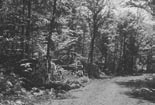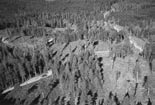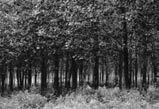C. Messier, B. Bigué and L. Bernier

Christian Messier is Professor and Scientific co-director of the
Ligniculture-Québec network, Department of Biological Sciences, University of
Quebec, Montreal, Quebec, Canada.
Brigitte Bigué is Coordinator of Ligniculture-Québec, Université Laval, Quebec City,
Quebec, Canada.
Louis Bernier is
Professor and Scientific co-director of Ligniculture-Québec, Department of
Wood Sciences and Forest, Université Laval, Quebec City, Quebec,
Canada.
Designating forest areas for varying levels of management intensity, from low intensity to super-intensive, could make it possible to set aside larger forest areas for full protection while maintaining wood production levels.
Canada has a vast forest resource of enormous economic importance, with forest product exports valuing US$22.5 billion in 2002 (FAO, 2003). Some 200 million cubic metres of wood are harvested every year in Canada, generating numerous economic offshoots in the various regions of the country, including almost 300 000 direct jobs, even without counting recreational and tourism activities. Yet in many parts of the country the allowable cut has already been reached and serious wood shortages are predicted within 25 years, despite the annual reforestation operations carried out in all provinces.
The situation is critical since there is growing pressure from society to increase protected areas; to modify forestry practices to protect biodiversity; and to maintain more old-growth forests within forests managed for wood production. In addition, there is a prospect that future climate change could increase the frequency of fire and insect outbreaks, further reducing the quantity of wood fibre available for harvesting.
This article proposes the adoption of a type of zoning principle to help deal with these new challenges and achieve sustainable management of Canadian forests. The approach would be to set aside different areas of forest for full protection and varying levels of management intensity for productive purposes. The management areas might cover the following range:
• full protection areas, in which logging is banned;
• low-intensity management areas, where some harvesting of wood is allowed but a relatively large quantity of standing trees, snags and deadwood is maintained following cutting (in Canada, often called new forestry, ecological forestry or ecosystem forest management);
• intensive management areas, where traditional intensive forestry interventions are used to increase wood production;
• super-intensive forestry areas (ligniculture), where priority is given to wood fibre production through short-rotation plantations.
With certain areas set aside for intensive and super-intensive forest management, high levels of wood production could be maintained on less land, and larger areas of forest than before could be fully protected. Some examples are also provided that show how intensive and super-intensive forestry can be used to help protect the environment.
The ultimate aim is obviously sustainable management of the forest. What does “sustainable” mean? According to the Brundtland Report, sustainable development is development that meets the needs of present generations, without compromising the ability of future generations to meet their own needs (Brundtland, 1987). In forestry, “sustainable management” generally refers to an approach for using the forest ecosystem that maintains both the integrity and health of forest ecosystems while maintaining their socio-economic contributions (CCFM, 1997). Indeed, to be sustainable, forest management must be ecologically viable, economically feasible and socially desirable.
The TRIAD principle (Hunter, 1990) is an interesting concept that can help in promoting sustainable forest management. This principle incorporates the conservation concepts of ecosystem management and full protection while pursuing the objective of wood production. The principle is based on a scenario whereby the forest area is divided into different management areas, each having a different set of goals and objectives. For example, the forest of Canada could be divided so that the ecosystem management approach would be applied on 74 percent of the forest area, while 12 percent would receive full protection and 14 percent would be devoted to intensive management.
Messier and Kneeshaw (1999) advocated a QUAD approach in which the intensively managed 14 percent would be divided further: 10 percent might be devoted to intensive management using traditional silvicultural techniques (classical clearcutting and planting with genetically improved trees, usually of indigenous species), while 4 percent would be under super-intensive management using more productive exotic and hybrid tree species (Figure).
Many regions of Canada are in the process of adopting some form of the TRIAD (Harris, 1984; Rowe, 1992; Hunter and Calhoun, 1996) or QUAD (Messier and Kneeshaw, 1999) approach. However, while the concept has been well developed for landscape goals, there have not yet been good descriptions of the stand-level treatments suitable for each of the above categories. With good planning and integration of stand-level treatments, managers may be able to develop forest areas that complement each other and together serve a wide variety of goals.

An example of how the productive forests of Canada could be
divided
into
four different zones to promote sustainable forest management
Range of stand treatments
Four categories of silvicultural treatments or systems used in Canada might provide managers with a range of stand management options that would probably be acceptable in forest areas where harvesting is allowed (not protected areas):
• systems emulating natural processes;
• semi-natural systems;
• traditional intensive systems;
• super-intensive systems.
These systems cover the extremes from ecosystem restoration to intensive plantation systems. The division into only four categories is arbitrary, as in reality the categories listed fit on a gradient from no intervention to extreme intervention. While it may be desirable to create various zones to meet timber, social and biodiversity objectives, managers should be given some flexibility to create a range of stand types using different silvicultural procedures.

Example of a system emulating natural
processes: selective logging in a temperate deciduous
forest of Quebec imitates the natural gap dynamic of these
forests; only natural regeneration is allowed
(Photo: M. BEAUDET)

Example of a semi-natural system: a variable
retention cut in coastal British Columbia resembles the structure
that
remains following fire or windstorm; in such forests planting is possible but
natural regeneration is also
encouraged; main objectives are to harvest wood
and protect biodiversity (expected productivity is 1 to 2 m3/ha/year)
(Photo: M. BEAUDET)

Example of a traditional intensive system:
classical clearcutting and planting with genetically improved trees,
normally indigenous species, with wood production as the main goal (expected
productivity is 3 to 6 m3/ha/year)
(Photo: M. BEAUDET)

Example of a super-intensive system: hybrid
poplar plantation; this type of forestry is done on a small fraction of
the
country’s land and very high productivity is expected (greater than 9 m3/ha/year)
(Photo: M. BEAUDET)
Concentrating production in intensively managed areas
Intensive forest management makes it possible to achieve productivity gains over natural or extensively managed stands by harvesting trees at a relatively young age, just after the culmination of mean annual increment. Following careful establishment and planting density control, conifer plantations in Ontario and Quebec have yielded nearly 300 m3 per hectare by age 40 (J. Beaulieu, personal communication). In Canada, several poplar (Populus) hybrids have been the focus of intensive plantation operations. Relatively large plantations have been established in Ontario and southern British Columbia, and the current area in hybrid poplar plantations is about 7 000 ha nationwide (Van Oosten, 2000). Poplar plantations may yield up to 37 m3 per hectare per year in coastal British Columbia, but the yields are likely to be much lower in sites with colder winters and seasons of water stress (Table 1). Larch (Larix spp.) plantations in Quebec have produced 5 to 8 m3 per hectare in five to ten years or sawlog timber in 20 to 25 years.
Increased levels of management intensity, however, can also play an important part in maintaining wood supply in forested landscapes managed to maintain biological diversity (Binkley, 1997). The calculations shown in Table 2 demonstrate that with intensive management on a relatively small area, the same level of wood production can be maintained even if 15 percent of the area is set aside as reserves and a large part of the area (72 percent) is managed semi-naturally.
The calculations were carried out as follows. The productive boreal forest of Canada (140.5 million hectares) (Lowe, Power and Gray, 1996) was divided into four site classes. The area of each site class was estimated from the site index from different permanent sample plots in Canada and was based on the dominant species in each plot.
The productivity of the semi-natural category was intentionally estimated on the low side, since this category includes forest systems classified as “emulating natural processes” in which the regeneration lag may be slightly longer. The productivity estimates were scaled up for the plantation and super-intensive systems based on the overall values in the literature.
Using data on the state of Canada’s forests in 1998/1999 (Government of
Canada, 1999) the annual productivity of the boreal forest (annual allowable
cut) was estimated to be about 141 million cubic metres per year, with an actual
annual cut of 108 million cubic metres. The value of 166 million cubic metres
per year of wood available for harvest developed in the calculations of Table 2
is therefore well above the productivity of natural forests despite the
inclusion of reserves and the low productivity from a large part of the
landscape.
TABLE 1. Current and anticipated hybrid poplar growth rates for various regions of Canada (m3/ha/year)
Region or province |
Current growth
|
Anticipated future | ||
Best |
Average |
Best |
Average | |
Southern Quebec |
19 |
9 |
20 |
14 |
Quebec, boreal region |
– |
– |
12 |
10 |
Southeastern Ontario |
15 |
>12 |
18 |
14 |
|
Prairie Region and northeastern British Columbia |
n.a. |
12 |
19 |
16 |
|
Northern interior British Columbia |
– |
– |
20 |
17 |
|
Southern interior British Columbia |
30 |
– |
35 |
25 |
|
British Columbia coast |
37 |
23 |
45 |
35 |
Source: Van Oosten, 2000.
TABLE 2. Potential area, productivity and production of boreal forest in different site classes in Canada
|
Management category/ site index at age 50 |
Area |
Productivity |
Production |
|
Protected areas (15%) |
|||
|
<10 m |
9 097 |
– |
– |
|
10 to 15 m 7 |
196 |
– |
– |
|
15 to 20 m 4 |
646 |
– |
– |
|
>20 m |
142 |
– |
– |
|
Subtotal |
21 081 |
– |
– |
|
Semi-natural (72%) |
|
||
|
<10 m |
47 483 |
0.7 |
33 238 |
|
10 to 15 m |
35 979 |
1.0 |
35 979 |
|
15 to 20 m |
17 587 |
1.2 |
21 104 |
|
>20 m |
303 |
1.5 |
455 |
|
Subtotal |
101 352 |
– |
90 776 |
|
Plantations (10%) |
| ||
|
<10 m |
4 064 |
1.5 |
6 096 |
|
10 to 15 m |
4 797 |
3.0 |
14 391 |
|
15 to 20 m |
4 827 |
3.5 |
16 894 |
|
>20 m |
200 |
5.0 |
1 000 |
|
Subtotal |
13 888 |
– |
38 381 |
|
Super-intensive (3%) |
| ||
|
<10 m |
– |
– |
– |
|
10 to 15 m |
916 |
6.0 |
5 497 |
|
15 to 20 m |
3 000 |
9.0 |
27 000 |
|
>20 m |
300 |
15.0 |
4 500 |
|
Subtotal |
4 216 |
– |
36 997 |
|
Total |
140 537 |
166 154 | |
Note: Different levels of productivity were assumed for each area, and there was a bias to include more of the highly productive lands in the more intensive systems. No super-intensive management was applied to the productivity class of site index <10 m.
It appears possible, even desirable, to use increased yield, fast-growing plantations in Canada as a means of achieving wood fibre production while promoting the protection and conservation of the country's forest's biodiversity. To this end, it is necessary to be innovative and especially to address the issue of forest management at the landscape level. The implementation of fast-growing forest plantations on a small portion of the country's productive forest land could become part of the Canadian strategy to achieve the sustainable management of its forest. In the future, the establishment of fast-growing plantations and/or the introduction of fast-growing exotics or hybrids on a portion of the landscape may well be associated with forest ecosystem protection and not the reverse.
 Bibliography
BibliographyBinkley, C.S. 1997. Preserving nature through intensive plantation forestry: The case of forestland allocation with illustrations from British Columbia. Forestry Chronicle, 73: 553-559.
Brundtland, G.H. 1987. Our common future. New York, USA, Oxford University Press.
Canadian Council of Forest Ministers (CCFM). 1997. Criteria and indicators of sustainable forest management in Canada. Technical report. Ottawa, Canada, Natural Resources Canada – Canadian Forest Service.
FAO. 2003. FAOSTAT forestry data. Internet document: apps.fao.org/page/collections?subset=forestry
Government of Canada. 1999. The state of Canada's forests: 1998-1999. Publ. Fo1-6/1999E. Ottawa, Canada, Natural Resources Canada – Canadian Forest Service.
Harris, L.D. 1984. The fragmented forest, island biogeography and theory and the preservation of biotic diversity. Chicago, Illinois, USA, University of Chicago Press.
Haycock, N.E. & Pinay, G. 1993. Groundwater nitrate dynamics in grass and poplar vegetated riparian buffer strips during winter. Journal of Environmental Quality, 22: 273-278.
Hunter, M.L. 1990. Wildlife, forest and forestry – principles for managing forest for biodiversity. Englewood Cliffs, New Jersey, USA, Prentice Hall.
Hunter, M.L. & Calhoun, A. 1996. A triad approach to land-use allocation. In R.C. Szaro & D.W. Johnston, eds. Biodiversity in managed landscapes, p. 477-491. New York, USA, Oxford University Press.
Lowe, J.J., Power, K. & Gray, S.L. 1996. Canada's forest inventory 1991: the 1994 version. An addendum to Canada's forest inventory 1991. Information Report BC-X-362E. Victoria, BC, Canada, Pacific Forestry Centre, Canadian Forest Service, Natural Resources Canada. Available on the Internet: warehouse.pfc.forestry.ca/pfc/4590.pdf
Messier, C. & Kneeshaw, D. 1999. Thinking and acting differently for a sustainable management of the boreal forest. Forestry Chronicle, 75: 929-938.
Rowe, J.S. 1992. The ecosystem approach to forestland management. Forestry Chronicle, 68: 222-224.
Van Oosten, C. 2000. Activities related to poplar and willow cultivation and utilization in Canada 1996-1999. Report to the 21st session of the International Poplar Commission, Portland, Oregon, USA, 24-28 September 2000. Nanaimo, British Columbia, Canada, SilviConsult Woody Crops Technology Inc.